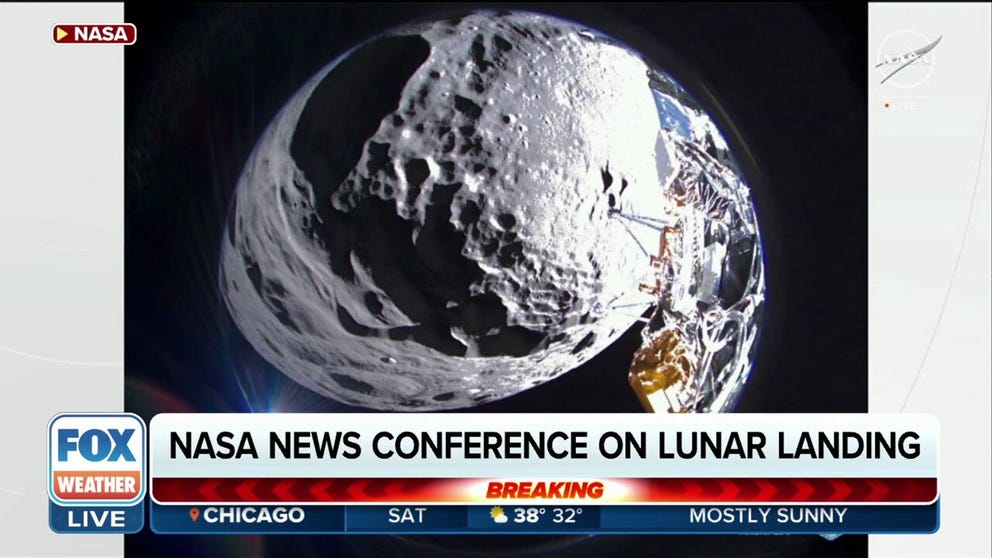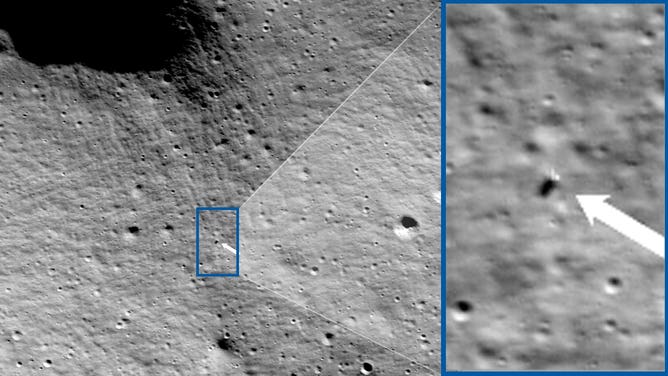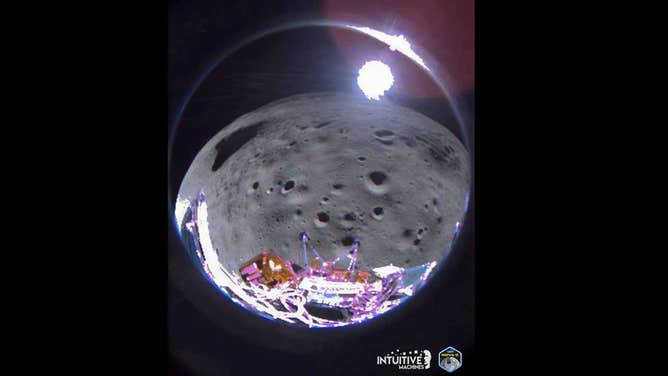Odysseus Moon lander sends back its first photo from lunar surface before entering 'nap' mode
NASA Administrator Bill Nelson said the Intuitive machines IM-1 mission is a “success from NASA’s point of view." Intuitive Machines landed the Nova-C lander Odysseus on the Moon on Feb. 22, nearly a week later the robotic mission is running out of time as lunar night approaches.
NASA, Intuitive Machines provide update on Moon lander
Officials from NASA and Intuitive Machines gave an update on the status of the Odysseus lander that touched down on the Moon on Thursday.
Intuitive Machine’s Nova-C Moon lander Odysseus will go to sleep after operating on the lunar surface a week after the private company returned the U.S. to the Moon for the first time since 1972.
Intuitive Machines launched its lunar lander on a SpaceX rocket earlier this month before a nail-biting landing on the Moon on Feb. 22. Odysseus, or "Odie," landed, but flight controllers later learned the robotic lander had tipped over in the process. New photos released on Wednesday show the lander coming in for landing, using its engine to throttle and "gently" leaning into the lunar surface.
INTUITIVE MACHINES RETURNS AMERICA TO MOON’S SURFACE FOR FIRST TIME SINCE 1972
Another photo taken on Tuesday was the image the world was waiting for, showing Odie on the surface of the Moon. Engineers said previous attempts to get photos from the surface "returned unusable imagery."

This image taken on February 27, 2024, when flight controllers commanded Odysseus to capture a new image using its narrow-field-of-view camera. (Image: Intuitive Machines)
The lander touched down near the shadowed region of the lunar South Pole. If the solar panels generated enough power before lunar night set over the lander, the mission was expected to operate for about 8 days on the Moon.
Intuitive Machines CEO Steve Altemus said Odie will go to "sleep" when the solar panels are no longer getting sunlight in hopes that they can power the lander back up when the area of the Moon begins receiving sunlight again in a few weeks.
ODYSSEUS MOON LANDER CONTINUES TO SEND BACK PHOTOS SHOWING UNEXPLORED REGION NEAR LUNAR SOUTH POLE
"We are projecting a time where the solar power generation will not allow data to continue sending down telemetry, but we will put Odie to sleep and expect to wake them up here in the next two or three weeks for a development test objective," Altemus said.
On Thursday, the seventh day of lunar operations, Intuitive Machines said Odysseus continued to operate on the lunar surface. Around noon, flight controllers were going to get the last data from Odie before placing the lander into a configuration to help it "phone home if and when he wakes up when the sun rises again," Intuitive Machines said.
Intuitive Machines Chief Technology Officer Tim Crain said they are optimistic the lander will wake up after "taking a nap."
"I would not bet against Odie," Crain said.
There is hope for an extended mission. Japan's SLIM lander, also near the Moon's South Pole, survived the lunar night and is once again communicating with Earth. The small lander survived weeks of temperatures at -200 degrees without sunlight before coming back online this week.
Even with the positioning of Odie on its side, NASA Bill Nelson and Intuitive Machines founders have called it a mission success.
LUNAR LANDER CAPTURES STUNNING PHOTOS OF EARTH BEFORE MOON LANDING ATTEMPT
NASA said it had received data from all six of its payloads on the IM-1 mission.
"Odysseus is a success from NASA’s point of view. There is a big difference in landing a bunch of instruments and landing a crew," Nelson told reporters on Wednesday.

This image captures Odysseus’ landing strut during landing on February 22, 2024 performing its primary task, absorbing first contact with the lunar surface. Meanwhile, the lander’s liquid methane and liquid oxygen engine is still throttling, which provided stability. (Image: Intuitive Machines)
NASA plans to land astronauts at the South Pole in the next few years. The space agency is relying on data from missions, like IM-1, under its Commercial Lunar Payload Services (CLPS) to provide information on what it takes to land and successfully operate in this hostile region of the Moon.
"The South Pole is pockmarked with craters, and because of the angle of the sunlight, those craters are constantly shadowed in darkness and therefore, the landing has to be very, very precise," Nelson said. "All of the data that we are going to get from these CLPS missions before Artemis 3 ever touches down is going to be extraordinarily valuable."
Intuitive Machines is already planning another lunar mission known as IM-2. Crain said this first mission set the bar high for the company's second Moon mission.





